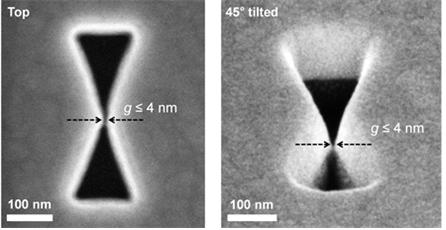3D Plasmonic Antenna Capable of Focusing Light into Few Nanometers

Figure 1: 3D Gap-Plasmon Antenna Structure and the Simulation Results Copyright : KAIST
Professors Myung-Ki Kim and Yong-Hee Lee of the Physics Department at KAIST and their research teams developed a 3D gap-plasmon antenna which can focus light into a few nanometers wide space. Their research findings were published in the June 10th issue of Nano Letters.
Focusing light into a point-like space is an active research field as it finds many applications. However, concentrating light into a smaller space than its wavelength is often hindered by diffraction. In order to tackle this problem, many researchers have utilized the plasmonic phenomenon in a metal where light can be confined to a greater extent by overcoming the diffraction limit.
Many researchers focused on developing a two dimensional plasmonic antenna and were able to focus light under 5 nanometers. However, this two dimensional antenna reveals a challenge that the light disperses to the opposite end regardless of how small it was focused. For a solution, a three dimensional structure has to be employed in order to maximize the light intensity.
Adopting the proximal focused-ion-beam milling technology, the KAIST research team developed a three dimensional 4 nanometer wide gap-plasmon antenna. By squeezing the photons into a three dimensional nano space of 4 x 10 x 10 nm3 size, the researchers were able to increase the intensity of light 400,000 times stronger than that of the incident light.
Capitalizing on the enhanced intensity of light within the antenna, they intensified the second-harmonic signal and verified that the light was focused in the nano gap by scanning cathodoluminescence images.
This technology is expected to improve the speed of data transfer and processing up to the level of terahertz (one trillion times per second) and to enlarge the storage volume per unit area on hard disks by 100 times. In addition, high definition images of sub-molecule size can be taken with actual light, instead of using an electron microscope, while it can improve the semiconductor process to a smaller size of few nanometers.
Professor Kim said, “A simple yet genuine idea has shifted the research paradigm from 2D gap-plasmon antennas to 3D antennas. This technology sees numerous applications including in the field of information technology, data storage, image medical science, and semiconductor process.”
The research was sponsored by the National Research Foundation of Korea.
Associated links
KAIST article
Media Contact
More Information:
http://www.researchsea.comAll latest news from the category: Physics and Astronomy
This area deals with the fundamental laws and building blocks of nature and how they interact, the properties and the behavior of matter, and research into space and time and their structures.
innovations-report provides in-depth reports and articles on subjects such as astrophysics, laser technologies, nuclear, quantum, particle and solid-state physics, nanotechnologies, planetary research and findings (Mars, Venus) and developments related to the Hubble Telescope.
Newest articles

Superradiant atoms could push the boundaries of how precisely time can be measured
Superradiant atoms can help us measure time more precisely than ever. In a new study, researchers from the University of Copenhagen present a new method for measuring the time interval,…

Ion thermoelectric conversion devices for near room temperature
The electrode sheet of the thermoelectric device consists of ionic hydrogel, which is sandwiched between the electrodes to form, and the Prussian blue on the electrode undergoes a redox reaction…

Zap Energy achieves 37-million-degree temperatures in a compact device
New publication reports record electron temperatures for a small-scale, sheared-flow-stabilized Z-pinch fusion device. In the nine decades since humans first produced fusion reactions, only a few fusion technologies have demonstrated…





















